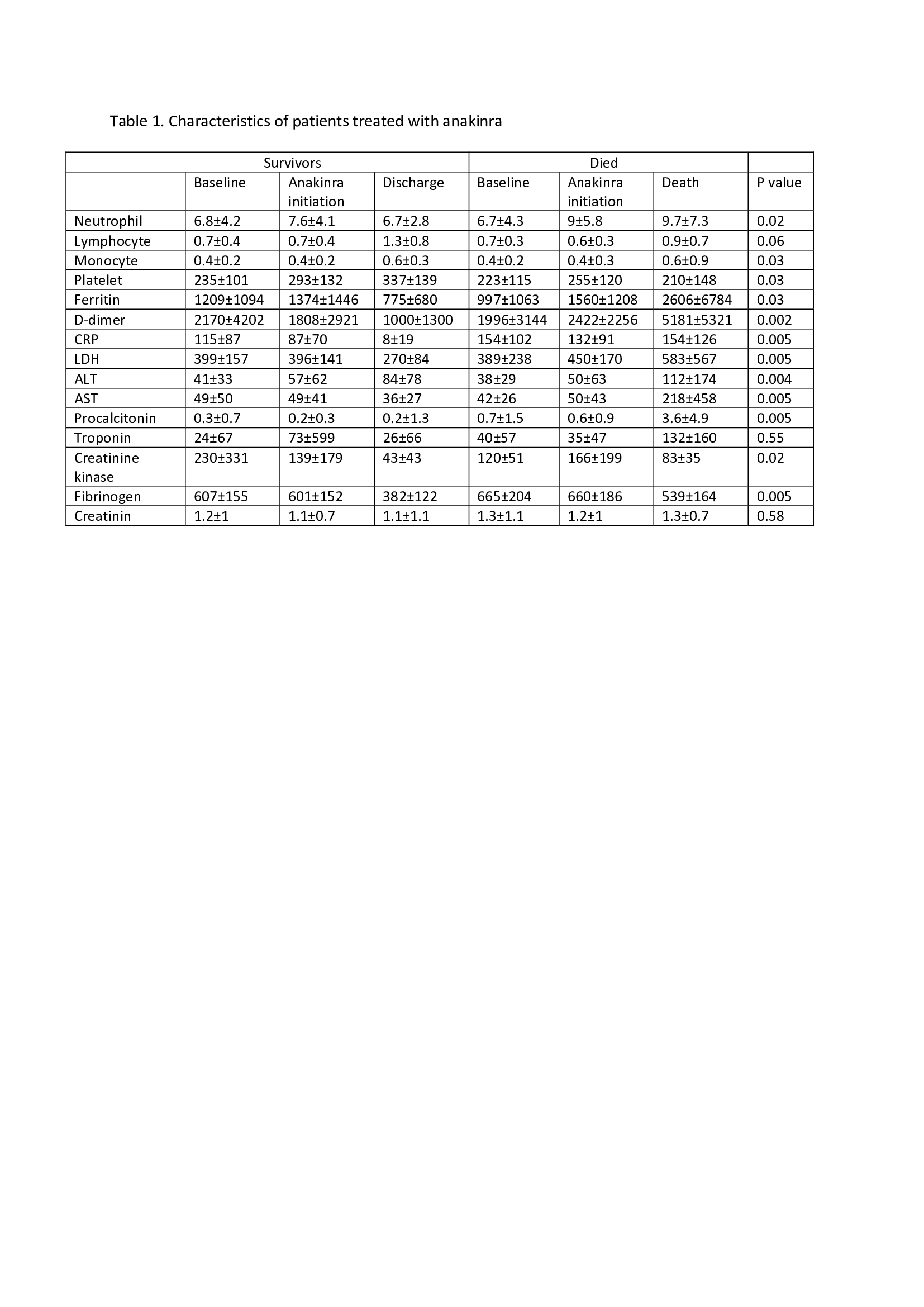Session Information
Session Type: Poster Session D
Session Time: 8:30AM-10:30AM
Background/Purpose: Coronavirus Disease 2019 (COVID-19) runs a severe course in a subset of patients with acute respiratory distress syndrome and multiorgan failure, and a hyperinflammatory syndrome compatible with features of macrophage activation syndrome (MAS) contributes to this worse outcome. Glucocorticoids have become standard of care for those requiring oxygen support or mechanical ventilation. More targeted anti-inflammatory treatment with tocilizumab and anakinra have also been shown to be effective, however, more studies are being awaited to clarify the features of patients who would benefit more. We, therefore, investigated characteristics of the patients who received anakinra in a single tertiary referral center.
Methods: The records of hospitalized adult COVID-19 patients between March 2020 and May 2021 were retrospectively analyzed, and those patients diagnosed with MAS and who received anakinra treatment constituted the study group. Diagnosis of COVID-19 was confirmed by RT-PCR or typical findings on computed tomography. Diagnosis of MAS was based on expert opinion and the preliminary criteria developed by the investigators. All laboratory features and clinical findings were recorded using a standard form. Anakinra dose was determined according to the needs of the patients mainly determined by the inflammatory parameters, varying 100-300 mg/day SC to 400-800 mg/day IV.
Results: Out of 1080 COVID-19 patients, 218 (151 male, 67 female, mean age 60.6±15.2) who received anakinra were identified. Among them, 125 (57.3%) patients followed in the ward, 21(9.6%) did not need oxygen treatment during the hospitalization. Sixty-nine (31.6%) patients followed at ICU, 40 of them were intubated, 30 (13.7%) died in ICU. Despite similar baseline values with an exception of lower procalcitonin levels in survivors, dead patients had higher CRP, ferritin, D-dimer, and LDH levels at the anakinra initiation (Table 1). Died patients did not show a significant response in CRP, ferritin, and D-dimer values, and they had even higher ferritin and a 2-fold increase in D-dimer levels on the day of death. Laboratory follow-up studies also revealed an increase in procalcitonin, troponin, transaminase levels in dead patients indicating contribution of accompanying secondary infections. A similar pattern was observed when patients followed in the ward and ICU were analyzed separately (Table 2).
Conclusion: Laboratory parameters predicting the outcome of anti-cytokine treatments in the management of hyperinflammatory response associated with COVID-19 are urgently needed. Analysis of this cohort of patients indicates that earlier use of anakinra treatment in hospitalized patients provides better results, and a decrease in CRP, ferritin, and D-dimer values, as well as an increase in lymphocyte count, are associated with favorable outcomes. Increasing values of D-dimer and troponin during the anakinra treatment were found to be associated with worse outcomes, possibly indicating cardiovascular and thrombotic pathologies not responding well to anakinra.
To cite this abstract in AMA style:
Amikishiyev S, Deniz R, Gunver M, Aghamuradov S, Koca N, Ince B, Bektas M, Durak G, Kose M, Erelel M, Çağatay A, Besısık S, Esen F, Gül A. Potential Predictors of Outcome for Anakinra Treatment in COVID-19 Patients with Macrophage Activation Syndrome [abstract]. Arthritis Rheumatol. 2021; 73 (suppl 9). https://acrabstracts.org/abstract/potential-predictors-of-outcome-for-anakinra-treatment-in-covid-19-patients-with-macrophage-activation-syndrome/. Accessed .« Back to ACR Convergence 2021
ACR Meeting Abstracts - https://acrabstracts.org/abstract/potential-predictors-of-outcome-for-anakinra-treatment-in-covid-19-patients-with-macrophage-activation-syndrome/


